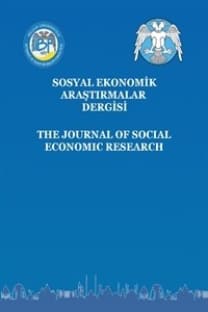2011 AVRUPA YEŞİL BAŞKENTİ HAMBURG: EKO-KENT KRİTERLERİ VE PERFORMANS GÖSTERGELERİ AÇISINDAN İNCELENMESİ
Çevre sorunlarının yıkıcı etkilerini birebir hissettiğimiz günümüzde, bu sorunların en önemli kaynağının insan aktiviteleri ve kentleşme olduğu bir gerçektir. Dolayısıyla, çok geç olmadan, mevcut kentleşme formlarından, doğa ve insan ilişkisini ön plana çıkaran, çevre dostu kent formlarına geçilmesi kaçınılmazdır. Bu amaçla, bu çalışmada sürdürülebilir kentler, eko-kentler, yeşil kent gibi çeşitli isimler verilen bu kent formları için Avrupa Birliği’nde ve dünyada uygulanan mevcut değerlendirme ölçütlerinin incelenmesi ve karşılaştırılması amaçlanmıştır. Ayrıca, Avrupa 2011 Yeşil Başkenti seçilen Hamburg şehri, bu ölçütlerde verilen parametreler bazında incelenerek değerlendirilmiştir.
Anahtar Kelimeler:
Eko-kent, Sürdürülebilir Kent, Hamburg, Yeşil Kent Endeksi
EXAMINING HAMBURG, EUROPEAN GREEN CAPITAL OF 2011, IN TERMS OF ECO-CITY CRITERIA AND PERFORMANCE INDICATORS
Nowadays, destructive impacts of environmental problems are heavily felt and it is well known that human activities and urbanization are the main reasons behind those environmental problems. Cities are consuming for around two thirds of all energy used, 60 percent of all water consumed and 70 percent of all greenhouse gases produced worldwide.Therefore, it is necessary the challenge of urban design forms towards environmental friendly cities in which nature-human mutual relations have a primary importance. Becausecities and metropolitan areas are the motors of economic growth and home to most jobs. They play a key role as centers of innovation and the knowledge economy. At the same time, urban areas are the frontline in the battle for social cohesion and environmental sustainability. Several terms are used to define cities where human-nature relations are in balance: eco-city, green city, silent city, sustainable city, etc. Whatever it is called, the city needs to meet both ecological and social requirements in an integrative approach. This includes optimum solutions for transport, energy, water management, waste management and thus creating a balance of natural, rural and urban development. Ecocity Builders (nonprofit organization founded in 1992 and dedicated to reshaping cities for the long-term health of human and natural systems) developed International Ecocity Framework and Standards (IEFS) initiative in 2010 to understand cities in their wholeness. They scaled cities from “unhealthy” through multiple levels of “greener city”, “ecocity” and the whole earth level “gaia”. The highest level (gaia or whole earth) describes a city that is in harmony socially and biophysically with its surrounding region and globally. Similarly, Ecocity Builders and associates’ definition of “ecocity” is conditional upon a healthy relationship of the city’s parts and functions, similar to the relationship of organs in living complex organism. We are concerned with city design, planning, building, and operations in an integral way and in relation to the surrounding environment and natural resources of the region, utilizing organic, ecological and whole-systems lessons to actually reverse the negative impacts of climate change, species extinction and the destruction of the biosphere. The ecocity model seeks to provide a practical vision for a sustainable and restorative human presence on this planet and suggests a path towards its achievement through the rebuilding of cities, towns and villages in balance with living systems. The Commission's European Sustainable Cities Report (EC 1996a) recognises the need for sustainability indicators as tools for quantifying sustainability performance. Along that line, there exist several performance indicators to evaluate city’s sustainability. In this paper, four of them are examined. Namely; European Urban Sustainability Indicators, Green City Index (Siemens), Ecocity Framework and Standards (IEFS) and ECOCITY criteria. First, European criteria for the evaluation of the cities' efforts is based upon the following 10 environmental indicator areas: Local contribution to global climate change, local mobility and passenger transportation, availability of local public open areas, quality of local ambient air, noise pollution, waste production and management, water consumption, waste water management, environmental management of the local authority and sustainable land use. Second, ‘Green City Index’ is sponsored by Siemens AG and developed by The Economist Intelligence Unit, ranked 30 major cities across Europe relative to one another in eight categories with 30 underlying qualitative and quantitative indicators. Green City Index seeks to measure and rate the environmental performance of 30 leading European cities both overall and across a range of specific areas. In so doing, it offers a tool to enhance the understanding and decision-making abilities of all those interested in environmental performance, from individual citizens through to leading urban policymakers.
Keywords:
Eco-city, Sustainable City, Hamburg, Green City Index,
- ISSN: 2148-3043
- Yayın Aralığı: Yılda 2 Sayı
- Başlangıç: 2000
- Yayıncı: Selçuk Üniversitesi
Sayıdaki Diğer Makaleler
PARÇACIK SÜRÜ OPTİMİZASYONU YAKLAŞIMI İLE EMTİA PİYASASINDA PORTFÖY OPTİMİZASYONU
Esra AYTAÇ, Muhsin ÖZDEMİR, Selim BEKÇİOĞLU
REEL DÖVİZ KURU VE DIŞ TİCARET İLİŞKİSİ: TÜRKİYE ÖRNEĞİ (2003 - 2010)
Zeynep KARAÇOR, Mustafa GERÇEKER
CUMHURBAŞKANININ HALK TARAFINDAN SEÇİLMESİ VE CUMHURBAŞKANI SEÇİM KANUNU
Orhan ÇINAR, Selahattin YAVUZ, İmran ASLAN
MESLEKÎ VE ÖRGÜTSEL BAĞLILIĞIN, ÖRGÜTSEL DAVRANIŞA İLİŞKİN SONUÇLARLA İLİŞKİLERİ
